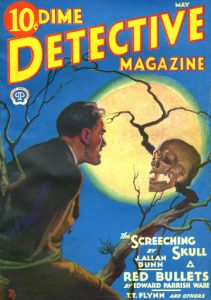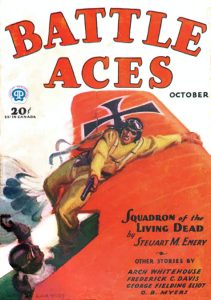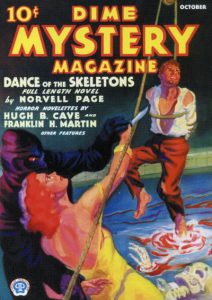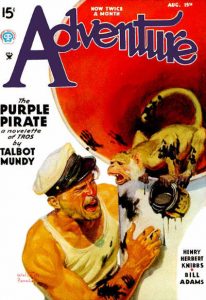Pulp magazines have influenced writers, artists, film directors, software developers, and countless others over the years. Our “Pulp History” articles focus on the rough-paper writers, editors, publishers, and artists who have inspired and continue to inspire the creators of the world’s popular culture.
 In late 1926, Henry Steeger, III was hired by Dell Publications to serve as co-editor of Famous Story Magazine, a 25¢ pulp magazine that reprinted stories from Cosmopolitan, Harper’s, The Ladies’ Home Journal, and other publications. Before long, the Princeton graduate was assistant editor of War Birds and the editor of Sky Riders, two of Dell’s aviation titles. In 1929, he became the editor of The Funnies, the first American comic book featuring original material.
In late 1926, Henry Steeger, III was hired by Dell Publications to serve as co-editor of Famous Story Magazine, a 25¢ pulp magazine that reprinted stories from Cosmopolitan, Harper’s, The Ladies’ Home Journal, and other publications. Before long, the Princeton graduate was assistant editor of War Birds and the editor of Sky Riders, two of Dell’s aviation titles. In 1929, he became the editor of The Funnies, the first American comic book featuring original material.
In the fall of 1929, while still employed by Dell, Steeger approached the business manager of Ace Publications — his longtime friend and former schoolmate, Harold Sanford Goldsmith — about starting a publishing company. Armed with a $125,000 line of credit arranged by Eastern Distributing Company, the two men launched Popular Publications.
According to pulp scholar David Saunders, “In May of 1930 Henry Steeger and Harold Goldsmith rented a one-room office for Popular Publications at 220 East 42nd Street in New York City. The newly-opened building was a massive skyscraper, of which the first ten floors were the headquarters of The Daily News.”
Using his contacts developed during his time with Dell, Steeger was able to buy work from some of the leading pulp writers of the time — Robert Sidney Bowen, Harold F. Cruickshank, Ralph Cummins, Frederick C. Davis, J. Allen Dunn, George Fielding Eliot, Steuart M. Emery, Erle Stanley Gardner, F. V. W. Mason, O. B. Myers, Arch Whitehouse, and others. The cover art was handled by freelance cover artists such as Rudolph Belarski, Frederick Blakeslee, Fred Craft, Don Hewitt, William Reusswig, and Sidney Riesenberg.
 Following the usual summertime lull in the pulp industry, Steeger and Goldsmith debuted their first four magazines, all dated October 1930. The print run for each title — Battle Aces, Detective Action Stories, Gang World, and Western Rangers — was 100,000.
Following the usual summertime lull in the pulp industry, Steeger and Goldsmith debuted their first four magazines, all dated October 1930. The print run for each title — Battle Aces, Detective Action Stories, Gang World, and Western Rangers — was 100,000.
Unfortunately, all but Battle Aces lost money for the new company. Earning just enough money to stay afloat, Steeger and Goldsmith decided to debut two new titles in the fall of 1931. Both dated November 1931, they were the short-lived Underworld Romances (four issues) and Dime Detective Magazine.
With a title suggested by one of Popular’s wholesalers — possibly in response to Ned Pines’ new “Thrilling” line of 10¢ titles — Dime Detective was an instant hit. Again, Steeger was able to line up stories by such talented and popular writers as Carroll John Daly, J. Allen Dunn, T. T. Flynn, Erle Stanley Gardner, and Frederick Nebel. Cover chores for the early issues were handled by William Reusswig. Like the “Thrilling” pulps, Dime Detective lived up to its billing and cost one thin dime.
With America in the throes of The Great Depression, Dime Detective became the cornerstone for a line-up of similarly titled and priced magazines. Dime Mystery Book Magazine (later shortened to Dime Mystery) and Dime Western debuted with their December 1932 issues, while Dime Adventure and Dime Sport Magazine premiered with their June and July 1935 numbers.
In 1933, a Popular Publications house ad proclaimed:
“In these days when most of us are trying desperately to make half as much go twice as far, the instant success of Popular Publications’ new group of dime magazines is not to be wondered at. There was never any doubt in our minds that there were just as many people who like to read good red-blooded adventure fiction as there were in the old prosperity days. The problem was to give it to them at a depression price — without sacrificing the high quality which all readers of Popular Publications have learned to expect. We solved the problem. The magazine you now hold in your hands is one proof of that statement.”
 According to Henry Steeger, “the profits were rolling in! There was gold in them thar hills! We saw the whole field as being ready for vast expansion and we were only too anxious and youthful to take advantage of it.”
According to Henry Steeger, “the profits were rolling in! There was gold in them thar hills! We saw the whole field as being ready for vast expansion and we were only too anxious and youthful to take advantage of it.”
Popular was soon adding more and more titles to their line-up: Dare-Devil Aces, Battle Birds, G-8 and His Battle Aces, The Spider, Star Western, Big-Book Western Magazine, Operator #5, Dusty Ayres and His Battle Birds, Terror Tales, Horror Stories, Rangeland Romances, Detective Tales, 10 Story Western Magazine, Ace G-Man, Love Book Magazine, Sports Novels, .44 Western Magazine, Strange Detective Mysteries, Astonishing Stories, Love Short Stories, Super Science Stories, New Detective Magazine, New Love Magazine, Romance, Fifteen Western Tales, Love Novels Magazine, New Sports Magazine, Fifteen Sports Stories, and many other titles.
Beginning in the mid-thirties, Popular also began purchasing some of the leading pulp titles from other publishers — Adventure (1934), Ace-High Magazine (1936), Black Mask (1940), and Munsey’s All-Story Love, Argosy, Famous Fantastic Mysteries, Fantastic Novels Magazine, Flynn’s Detective Fiction, and Railroad Magazine (1943). In 1949, Steeger and Goldsmith also acquired the recently canceled Street & Smith pulp titles, with the exception of Astounding Science Fiction, Doc Savage, The Shadow, and the company’s other hero titles. In 1952, Popular revived Love Story, Western Story, and Detective Story Magazine.
 Based upon the grids found in The Adventure House Guide to the Pulps (2000), Popular was publishing nearly fifty magazines over a two-month period in 1943. Interestingly, in early 1950 — when the pulps were in their death throes — Popular published as many as 55 magazine issues over a two-month period. All told, excluding the men’s adventure versions of Argosy and Adventure, Popular published nearly 5,000 pulp issues during their 25+ years in the pulp industry.
Based upon the grids found in The Adventure House Guide to the Pulps (2000), Popular was publishing nearly fifty magazines over a two-month period in 1943. Interestingly, in early 1950 — when the pulps were in their death throes — Popular published as many as 55 magazine issues over a two-month period. All told, excluding the men’s adventure versions of Argosy and Adventure, Popular published nearly 5,000 pulp issues during their 25+ years in the pulp industry.
Although their pulp line ended in 1955, Popular continued to publish Adventure until 1971 and Argosy until 1978.
Not a bad return for one thin dime.
Ninety years ago, the fledgling Popular Publications released a new magazine to America’s newsstands. With three of their four pulp magazines losing money, partners Harold Goldsmith and Henry Steeger decided to take a new direction. They sliced their usual 20¢ price in half and filled their new pulp with stories by popular writers like Erle Stanley Gardner and Frederick Nebel.
DIME DETECTIVE MAGAZINE was a resounding success. It helped turn Popular Publications into a pulp juggernaut. The May 1932 issue of DIME DETECTIVE is the seventh issue of the title and features artwork by William Reusswig, who painted many covers for Popular during its formative years.
Of its four original titles, BATTLE ACES was the only magazine that turned a profit during Popular’s first year of existence. Pictured here is the first issue of the pulp, dated October 1930 and featuring cover art by Don Hewitt.
Freelance artist Walter M. Baumhofer began contributing cover paintings to Popular Publications in late 1932. For the next eight years, the artist painted dozens of covers for ADVENTURE, BIG-BOOK WESTERN MAGAZINE, DETECTIVE TALES, DIME MYSTERY, DIME WESTERN, THE SPIDER, and STAR WESTERN. During the 1950s, he created covers and interior illustrations for Popular’s ARGOSY. Pictured here are the October 1933 DIME MYSTERY MAGAZINE and the August 15, 1935 number of ADVENTURE. The featured image is the artist’s cover art for the April 1933 DIME WESTERN MAGAZINE.
David Saunders’ biographical sketches of Harry Steeger and Harold Goldsmith — found on his “Field Guide To Wild American Pulp Artists” website — proved invaluable in the preparation of this article. Additionally, “An Interview with Henry Steeger” — conducted by Nils Hardin and found in the July 1977 issue of XENOPHILE (Number 33) — and Chapter 4, “Brother, Can You Spare A Dime?” — found in THE DIME DETECTIVES, written by Ron Goulart and published by The Mysterious Press (1988) — were also quite helpful.
Other resources include THE BLOOD ‘N’ THUNDER GUIDE TO PULP FICTION, by Ed Hulse (2013), THE SHUDDER PULPS, by Robert Kenneth Jones (1975), WORDSLINGERS: AN EPITAPH FOR THE WESTERN, by Will Murray (2013), “The Reign of the Rajah,” by Will Murray in PURPLE PROSE #17 (2003), “Notes and Name Droppings from an Editor’s Chair,” by Henry Steeger with Michael Chomko in PURPLE PROSE #16 (2002), and DIME DETECTIVE COMPANION, by James L. Traylor (2011). If you’re interested in either issue of PURPLE PROSE, please contact me at mike@pulpfest.com.
Michael Chomko, the winner of the 2010 Munsey Award, is the marketing and programming director for PulpFest. A registered nurse, Mike sells books on a part-time basis, operating as Mike Chomko, Books. His specialty is pulp-related material.







